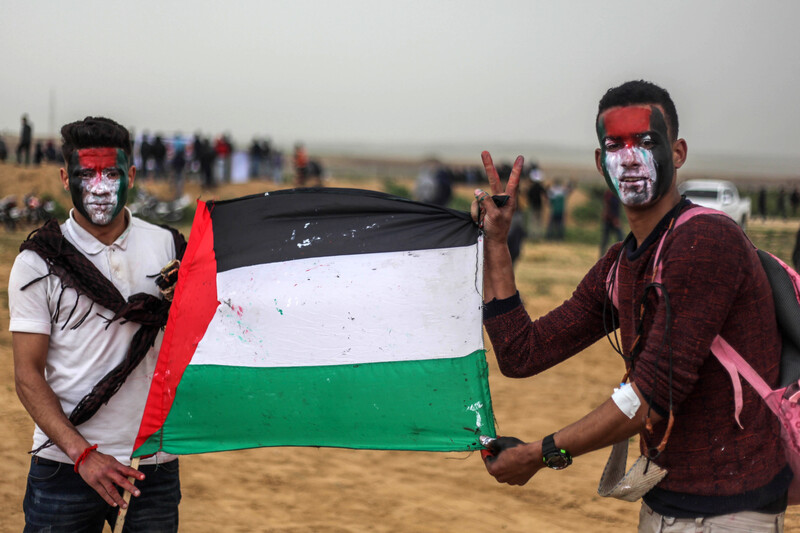Rights and Accountability 30 March 2019

Tens of thousands of Palestinians took part in rallies in Gaza along the boundary fence with Israel on 30 March, marking Land Day and the first anniverary of the Great March of Return.
APA imagesAmid a festive atmosphere, tens of thousands of Palestinians gathered in Gaza along the boundary fence with Israel on Saturday to mark the first anniversary of the Great March of Return.
They were also marking Land Day, the annual commemoration of Israel’s lethal suppression of protests against land confiscations in the Galilee in 1976.
Like every week over the last year, unarmed protesters demanded an end to the decade-long siege of Gaza and asserted their right to return to familial lands now in Israel and were met with lethal force by Israeli occupation forces stationed across the fence.
Adham Nidal Amara, 17, was directly injured in his face, killing him, as he took part in the rallies east of Gaza City.
Tamer Hisham Abu al-Khair, 19, was fatally shot in the chest, east of Khan Younis.Bilal Mahmoud Shaban Najjar, 16, was shot in the stomach, also east of Khan Younis, and died in hospital.
Media circulated photos of the slain Palestinians after their deaths. Images also showed medics trying to save the life of Adham Amara: Early on Saturday, the health ministry announced the death of 20-year-old Muhammad Jihad Saad from injuries he sustained east of Gaza City before the day’s marches began.Throughout the day, more than 300 people were injured as Israeli forces fired tear gas, rubber-coated metal bullets and live ammunition at march participants.
More than 60 Palestinians were shot with live bullets, according to the health ministry.
Among those injured were medics:
Videos and photos show the large numbers of people who took part in the protests: The large turnout was despite Israel’s open threat of violence against protesters who approached the boundary fence: The Israeli military acknowledged that Hamas authorities in Gaza deployed hundreds of marshals in orange vests to keep Palestinians from approaching too close to the boundary fence – a measure that likely saved lives from indiscriminate Israeli sniper fire.Israeli officials also asserted that the intense violence they meted out against Gaza in the last week in the form of dozens of airstrikes, including one against the office of Hamas leader Ismail Haniyeh, “contributed to the day’s relative calm,” as The Times of Israel put it.
In keeping with this official Israeli mindset that Palestinians only respond to force, some Israeli ministers chose Saturday to incite further violence and escalation.
Education minister Naftali Bennett and justice minister Ayelet Shaked, both of the New Right Party, vowed to oppose a long-term ceasefire deal that could ease conditions in Gaza, amid renewed reports that such an agreement was under discussion.
“It’s not for nothing that Israelis are feeling humiliated. [Hamas leaders Yahya] Sinwar and [Ismail] Haniyeh are celebrating victory, with no fear that Israel will eliminate them. That is not how to create a deterrence,” the two ministers told Israeli media.
Since the first Great March of Return rallies, Israeli forces have killed nearly 300 Palestinians in Gaza, 200 of them during unarmed protests, according to the Gaza-based human rights group Al Mezan.
Thousands more have been injured, including “many children, women, persons with disabilities and paramedics,” Al Mezan stated. “Hundreds of the injured suffer from the traumatic experiences of losing one or more limbs to amputation.”
Al Mezan observed that over the last year, “the root causes of the protests – being prolonged suffering in inhumane living conditions – were largely overlooked by the international community. At the same time, protesters’ fundamental rights to life, physical integrity and freedom of expression and of assembly, were systematically violated.”
The human rights group noted that just weeks ago, an independent UN commission of inquiry stated that Israel’s systematic use of lethal force against protesters may amount to war crimes and crimes against humanity.
The commission of inquiry report, adopted by the UN Human Rights Council a week ago, calls on third countries to consider imposing sanctions on the individuals responsible or to arrest them for trial.
Yet despite the staggering toll of death and injury, and calls for accountability, Al Mezan said that “the international community remains divided and hesitant to take a firm stance on the serious and increasing departures from international law standards and principles.”This was especially notable in the UN Human Rights Council vote in which only one of 10 European Union member states voted in favor of adopting the commission of inquiry report.
According to Al Mezan, the voting record demonstrates a “striking dissonance between states’ self-promotion as defenders of human rights and their failure to live up to their moral and legal obligations on Palestine.”
Yet after a year of weekly protests during which Israel has exacted a horrifying toll on unarmed civilians, Palestinians in Gaza demonstrated once again on Saturday their determination not to allow the world to forget them and leave them to their fate at Israel’s hands.
This story was updated to include the killing of Bilal Mahmoud Shaban Najjar and to update the ages and circumstances of other persons killed on 30 March.





Comments
Great March Coverage
Permalink Phil Ritter replied on
The NY Times coverage said there were homemade bombs being tossed over the border on Friday. I think that if this is not true EI should call them on it immediately and challenge them to provide evidence.